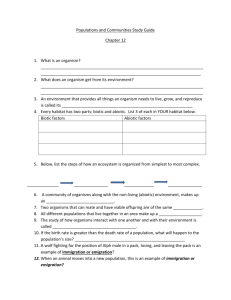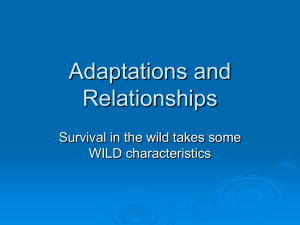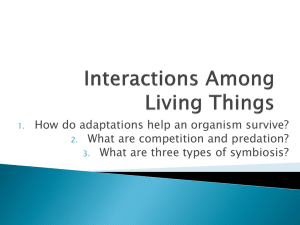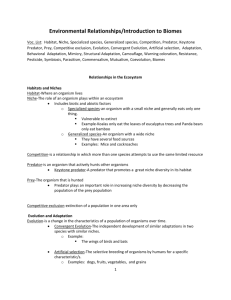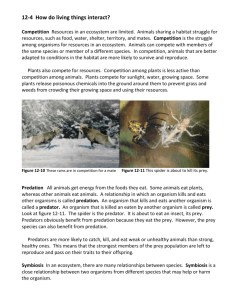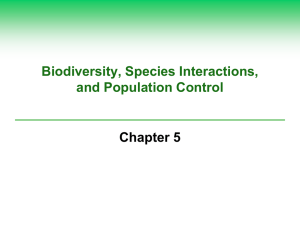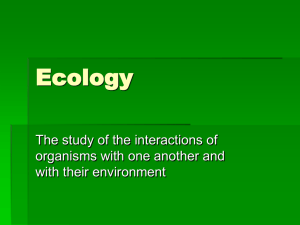Ecological Relationships
advertisement
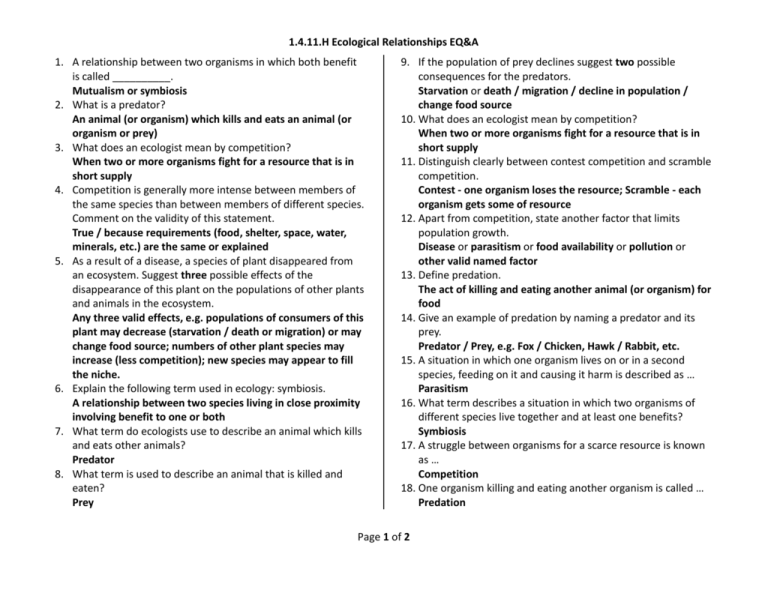
1.4.11.H Ecological Relationships EQ&A 1. A relationship between two organisms in which both benefit is called __________. Mutualism or symbiosis 2. What is a predator? An animal (or organism) which kills and eats an animal (or organism or prey) 3. What does an ecologist mean by competition? When two or more organisms fight for a resource that is in short supply 4. Competition is generally more intense between members of the same species than between members of different species. Comment on the validity of this statement. True / because requirements (food, shelter, space, water, minerals, etc.) are the same or explained 5. As a result of a disease, a species of plant disappeared from an ecosystem. Suggest three possible effects of the disappearance of this plant on the populations of other plants and animals in the ecosystem. Any three valid effects, e.g. populations of consumers of this plant may decrease (starvation / death or migration) or may change food source; numbers of other plant species may increase (less competition); new species may appear to fill the niche. 6. Explain the following term used in ecology: symbiosis. A relationship between two species living in close proximity involving benefit to one or both 7. What term do ecologists use to describe an animal which kills and eats other animals? Predator 8. What term is used to describe an animal that is killed and eaten? Prey 9. If the population of prey declines suggest two possible consequences for the predators. Starvation or death / migration / decline in population / change food source 10. What does an ecologist mean by competition? When two or more organisms fight for a resource that is in short supply 11. Distinguish clearly between contest competition and scramble competition. Contest - one organism loses the resource; Scramble - each organism gets some of resource 12. Apart from competition, state another factor that limits population growth. Disease or parasitism or food availability or pollution or other valid named factor 13. Define predation. The act of killing and eating another animal (or organism) for food 14. Give an example of predation by naming a predator and its prey. Predator / Prey, e.g. Fox / Chicken, Hawk / Rabbit, etc. 15. A situation in which one organism lives on or in a second species, feeding on it and causing it harm is described as … Parasitism 16. What term describes a situation in which two organisms of different species live together and at least one benefits? Symbiosis 17. A struggle between organisms for a scarce resource is known as … Competition 18. One organism killing and eating another organism is called … Predation Page 1 of 2 1.4.11.H Ecological Relationships EQ&A 19. Distinguish between contest competition and scramble competition by writing a sentence about each. Contest: (Results in) winner takes all (of a limited resource); Scramble: (Results in) each gets some (of a limited resource) 20. Name a factor, other than competition, that controls wild populations. Disease or parasitism or predation or hunting or reference to other named environmental condition 21. What deduction is it possible to make from the following observation? Mortality levels resulting from infection by a particular virus tend to decline over the years. (Host) immunity develops or comment on natural selection (or described) or most virulent strains die off or vaccination 22. What deduction is it possible to make from the following observation? There is a greater variety of herbaceous (non woody) plants in areas where grazing species, such as rabbits, are more plentiful than in areas where grazing species are less plentiful. (Grazing results in) reduced competition (or described) 23. What deduction is it possible to make from the following observation? In some species of migratory ducks in the northern hemisphere it is found that the wintering grounds of the males lie further south than those of the females. Any biological knowledge-based statement that would provide a plausible rationale for a differential migratory pattern 24. Suggest one way in which marking an animal might endanger it. More conspicuous (to predators) or social outcast or toxic marker 25. Distinguish between contest competition and scramble competition by writing a sentence about each. Contest: one gets all (of the resource); Scramble: all get some (of the resource) 26. Suggest a role for parasites in the overall scheme of nature. Population control 27. Name two predators. Give one adaptive technique in the case of each predator. e.g. Name - Fox, Adaptive technique - Speed and sharp canine teeth 28. Explain the term Symbiosis. Relationship between two species involving benefit 29. Explain the term Biotic factor. A living factor in an ecosystem 30. Give two possible effects on an ecosystem of the extinction of a plant species. Soil erosion / less nutrients / siltation / destroying aquatic ecosystems / decrease in consumer numbers / increase in numbers of other plant(s) / change of animal species Page 2 of 2




